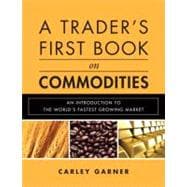
Carley Garner is Senior Market Analyst and Broker with DeCarley Trading and a columnist for Stocks & Commodities. The author of Commodity Options, Garner writes two widely distributed e-newsletters, The Stock Index Report and The Bond Bulletin.
Her work has been featured in Stocks & Commodities, Futures, Active Trader, Option Trader, Your Trading Edge, and PitNews Magazine. She has been quoted in media ranging from Reuters to Investor’s Business Daily and The Wall Street Journal. Garner provides free trading education to investors at www.decarleyrading.com.
Introduction The Rise and Fall of Commodities 1
A Commodity Rally for the History Books 1
A Day of Reckoning 7
The Speculators’ Role 8
Fortunes Made and Lost 10
Conclusion 13
Chapter 1: A Crash Course in Commodities 15
How It All Began 15
The CME Group 17
Evolution of the Forward Contract into a Futures Contract 18
Cash Market Versus Futures Market 21
Contract Expiration 23
The Mechanics of Futures Contracts 25
Futures Spreads 32
A Brief Introduction to Commodity Options 33
Chapter 2: Hedging Versus Speculating 37
Commodity Hedgers 37
Commodity Speculators 42
Chapter 3: The Organized Chaos of Open Outcry and the Advent of Electronic Trading 45
The Pit 46
Electronically Traded Markets 47
“Side by Side” 48
Costly Commodity Quotes 54
Open Outcry Quote Reporting and Access 54
Electronic Quote Transmission 56
Subscribing to Quotes 57
Charting 58
Free Trading Platforms and Market Access 58
Paid Trading Platforms 59
Auto Approval Versus Manual Approval 60
Order Desk (“The Desk”) 62
Is It Worth Paying Platform Fees or Subscribing to Quotes? 63
Chapter 5: Choosing a Brokerage Firm 65
Introducing Brokers, Futures Commission Merchants, and Broker/Dealers 66
Fill Quality 69
Behind the Scenes of Transaction Costs 70
Discount Brokerage or Full-Service Specialization 71
What You Should Know About Commission Structure: Blanket or Variable Rates? 72
Market Access 75
Beyond Your Broker 77
Conclusion 79
Chapter 6: Finding a Broker That “Fits” and Choosing a Service Level 81
Understand Your Broker’s Business 83
Get to Know Your Futures Broker 84
Full Service Broker or Self Directed Online? 88
Why Using a Broker May Be a Good Idea 90
Conclusion 93
Chapter 7: Order Types and How to Use Them 95
Order Types 95
Placing a Trade with Your Broker 108
Placing a Trade Online 111
Chapter 8: Making Cents of Commodity Quotes 113
Quoting Grain Futures 115
Not All Grains Are Created Equal 119
The Meats 122
Foods and Fiber 125
Precious Metals Futures 130
Gold, Platinum, and Palladium Futures 131
The Other Metal Futures 133
Chapter 9: Figuring in Financial Futures–Stock Indices, Interest Rates, and Currencies 137
The Boring but Necessary Basics 137
Stock Index Futures 138
Dow Jones Industrial Average Futures 141
NASDAQ 100 Futures 143
S&P 500 Futures 146
Russell 2000 Futures 151
Interest Rate Futures 151
Treasury Bond and Note Futures 153
Eurodollar Futures 164
Currency Futures 167
Conclusion 170
Chapter 10: Coping with Margin Calls 171
What Is Margin? 171
Day Trading Margin Versus Overnight Margin 172
How to Handle a Margin Call 173
The Margin Call Countdown 175
Accepting Margin Calls 177
Chapter 11: The Only Magic in Trading–Emotional Stability 179
Three Emotions in Trading: Fear, Greed, Frustration 181
Revengeful Trading Is Counterproductive 187
Capital Preservation aka Risk Management 188
Chapter 12: Trading Is a Business–Have a Plan 189
The Trading Game Plan 190
A Trading System Alone Isn’t a “Business Plan” 191
Constructing a Business Plan in Trading 195
Price Speculation (Ideally Prediction) 196
Choosing a Trading Vehicle 198
Risk Management 199
Chapter 13: Why You Should Speculate in Futures 207
Speculating in Futures Versus Speculating in Equities 208
Risk Capital Only 214
Conclusion 215
Chapter 14: Futures Slang and Terminology 217
Bull Versus Bear 217
Spread 219
Contract Month Slang 220
Red Months 220
Fill 221
Blow Out 222
Blow Up 222
Keypunch Error 222
Busted Trade or Moved Trade 223
Net Liq 224
Equity 224
Beans 225
Commodity Currency 226
Dead Cat Bounce 226
Bottom Fishing 227
Chasing the Market 227
Limit Moves 228
The Tape 228
Trading Solution and Front-End Platform 229
Proprietary Trading 229
Running Stops 229
Short Squeeze 230
Babysitting 230
Scalp 231
Slippage 231
Working Order 232
Unable 232
Handle 232
Overbought/Oversold 233
Debit/Account Debit 233
Round Turns 233
Trading Environment 234
Index 235
The New copy of this book will include any supplemental materials advertised. Please check the title of the book to determine if it should include any access cards, study guides, lab manuals, CDs, etc.
The Used, Rental and eBook copies of this book are not guaranteed to include any supplemental materials. Typically, only the book itself is included. This is true even if the title states it includes any access cards, study guides, lab manuals, CDs, etc.